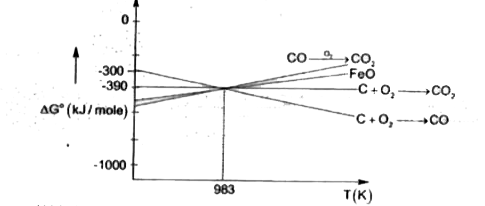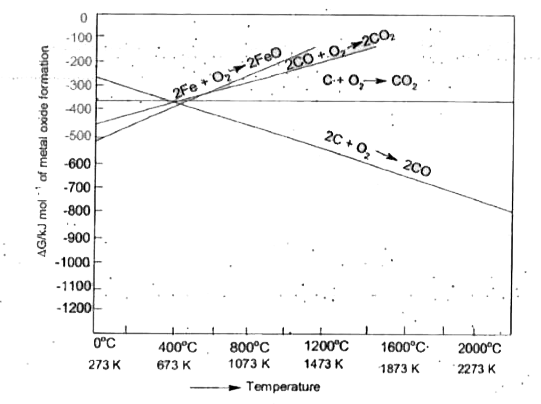Extraction of aluminum can be understood by

In Blast Furnace Fe2O3 is reduced to FeO in reduction zone by CO, where temperature varies from about 300 to 800∘C. By using given Ellingham diagram choose the correct statement(s) of the following ?

below 983 K FeO is reduced CO
above 983 K FeO can be reduced to Fe by CO
at 1000 K FeO is reduced by C in which CO formation is more favorable
at 983 K none of C and CO can completely reduce FeO to Fe
The correct Answer is:A, C, D
At 983 K there will be an equilibrium of all the process shown.
Topper's Solved these Questions
- ORES AND METALLURGYBook:FIITJEEChapter:ORES AND METALLURGYExercise:MATCHING TYPE SINGLE CORRECT QUESTION
Explore 6 Videos
- ORES AND METALLURGYBook:FIITJEEChapter:ORES AND METALLURGYExercise:MATRIX-MATCH THE FOLLOWING QUESTION
Explore 1 Video
- ORES AND METALLURGYBook:FIITJEEChapter:ORES AND METALLURGYExercise:REASONING TYPE QUESTIONS
Explore 13 Videos
- NUCLEIC ACID AND VITAMIN Book:FIITJEEChapter:NUCLEIC ACID AND VITAMIN Exercise:ASSIGNMENT PROBLEMS (OBJECTIVE)
Explore 15 Videos
- PERIODIC PROTERTIES OF ELEMENTSBook:FIITJEEChapter:PERIODIC PROTERTIES OF ELEMENTSExercise:COMPREHENSION
Explore 13 Videos
Similar Questions
Metals are extracted from their ores by a wide variety of techniques. The most common ores are oxides. Most metals are obtained by direct treatment of theirs ores with chemical agents, but the extraction of certain others require electrolysis. An example of the former type of process is the extraction of iron from its oxide, described by the following equation :
Fe2O3+3C→2Fe+3CO
The relative ease of extraction of a metal from its oxide can be estimated using the Ellingham diagram, as shown in the figure.
The diagram plots the free energies of formation of various oxides per mole of consumed oxygen as a function of absolute temperature.

Which of the following best explains why the free energy of formation of Fe2O3 becomes less negative as the temperature is increased.
View SolutionName the four main zones of blast furnace in the extraction of Fe from Fe2O3.
View Solution
Knowledge Check
Cr2O2−7 is reduced to Cr3+ by Fe2+ . Identify the correct statement from the following :
A6 moles of Fe2+ are oxidised to Fe3+ ionsBThe solution becomes yellowCThe solution becomes greenD3 moles of Fe2+ get oxidised to Fe3+The temperature (∘C) at which Fe2O3is finally reduced to Fe in the blast furnace is
A993B797C897D1597Metals are extracted from their ores by a wide variety of techniques. The most common ores are oxides. Most metals are obtained by direct treatment of theirs ores with chemical agents, but the extraction of certain others require electrolysis. An example of the former type of process is the extraction of iron from its oxide, described by the following equation :
Fe2O3+3C→2Fe+3CO
The relative ease of extraction of a metal from its oxide can be estimated using the Ellingham diagram, as shown in the figure.
The diagram plots the free energies of formation of various oxides per mole of consumed oxygen as a function of absolute temperature.
FIITJ∃CHEMB04_C02E07009_Q01.png width=80%><br>Whenferric⊗isreduced→obta∈ironmηl,CO_(2)orCOcanbe∏uced.The∏uctionofCO_(2)Ais directily proportional to the temperatureBis inversely proportional to the temperatureCis independent of the temperatureDrequires cooling of the CO
At temperature above 1073K coke can be used to reduce FeO to Fe. How can you justify this reduction with Ellingham diagram?
View SolutionName the four man zones of blast furnace in the extraction of Fe from Fe2O3.
View SolutionName the four man zones of blast furnace in the extraction of Fe from Fe2O3.
View SolutionMetals are extracted from their ores by a wide variety of techniques. The most common ores are oxides. Most metals are obtained by direct treatment of theirs ores with chemical agents, but the extraction of certain others require electrolysis. An example of the former type of process is the extraction of iron from its oxide, described by the following equation :
Fe2O3+3C→2Fe+3CO
The relative ease of extraction of a metal from its oxide can be estimated using the Ellingham diagram, as shown in the figure.
The diagram plots the free energies of formation of various oxides per mole of consumed oxygen as a function of absolute temperature.

Which of the following best explains why the free energy of formation of Fe2O3 becomes less negative as the temperature is increased.
View SolutionMetals are extracted from their ores by a wide variety of techniques. The most common ores are oxides. Most metals are obtained by direct treatment of theirs ores with chemical agents, but the extraction of certain others require electrolysis. An example of the former type of process is the extraction of iron from its oxide, described by the following equation :
Fe2O3+3C→2Fe+3CO
The relative ease of extraction of a metal from its oxide can be estimated using the Ellingham diagram, as shown in the figure.
The diagram plots the free energies of formation of various oxides per mole of consumed oxygen as a function of absolute temperature.

All of the following reagents could be used to extract lead from its oxide except
View Solution
